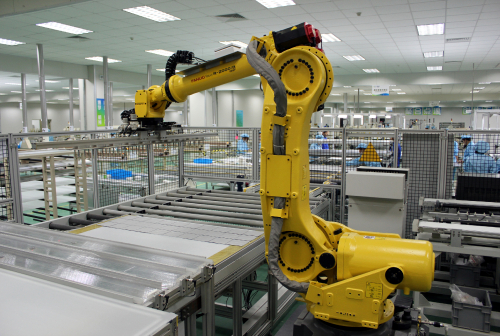Green Pioneer
Beijing Review by Deng Yaqing, September 7, 2015 Adjust font size:

A robot works at a solar panel production line in a CECEP's plant in Zhenjiang, east China's Jiangsu Province (COURTESY OF CECEP)
Ethos on display
To popularize the new living pattern, CECEP has developed 26 green building demonstration parks across the country, covering an area of 5.45 million square meters. Among them, the Hangzhou Energy and Environment Industrial Park cuts a figure with its Green Building Museum and its 2-megawatt roof-mounted photovoltaic power system.
The museum is equipped with 10 architectural energy saving systems—including a passive ventilation system, self-shading system for buildings, ground source heat pump system and a renewable energy elevator system—which help it save 72 percent of energy consumption and achieve the Leadership in Energy and Environmental Design Platinum rating, the highest green building identification recognized by the United States. In addition, its 2-megawatt roof-mounted photovoltaic power system can generate 2-million-kWh power every year, saving 3,000 tons of standard coal and cutting over 4,000 tons of carbon dioxide emission.
However, it's still an uphill road to promote green buildings these days, said Zhang Chao, Vice President of CECEP. For one thing, Chinese people still know little about green building, and the Central Government has not yet launched a corresponding policy encouraging the popularization of green building; for another, a focus needs to be laid on the real energy-saving effect rather than blindly pursuing more installations of energy-conserving systems, because there may be conflicts and overlaps among them.
"In the past three decades, China's industrialization and urbanization came at the expense of high energy consumption and high carbon emission. The government has begun to promote more scientific and greener production modes, but green life has not received equal attention," said Yang Mingsen, President of China Environment News, who is calling for the promotion of a green lifestyle.
He argued that residential building is a major part of green life and should undergo a thorough transformation.
"The green building projects operated by CECEP are not an unrealistic concept; rather, they represent a new direction for other companies to join and follow," said Yang.